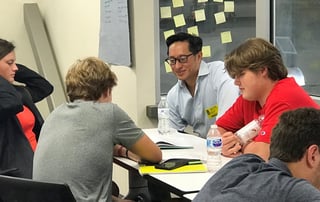When I was a student in the ’80s and ’90s, and even in the early 2000s when I first set foot in a classroom as an educator, education was mainly about consuming knowledge—memorizing facts, following rules, and regurgitating information. It was not always inspiring. Hands-on projects and open-ended problem solving were the exceptions, not the rule. We were preparing students to function in the traditional workplace. But then the world changed. Advances in technology and global connectedness ushered in new categories of jobs and workforce requirements, and the pandemic forced innovation in how we teach and learn. And schools have risen to the challenge. In the mid-late '90s, social-emotional learning was emerging as important. Educators talked about the soft skills students needed to thrive in a changing world. It was clear that students need not just to consume information and acquire hard skills, but to solve problems, to create, and to share their ideas with the world around them.
Advances in technology and global connectedness ushered in new categories of jobs and workforce requirements, and the pandemic forced innovation in how we teach and learn. And schools have risen to the challenge. In the mid-late '90s, social-emotional learning was emerging as important. Educators talked about the soft skills students needed to thrive in a changing world. It was clear that students need not just to consume information and acquire hard skills, but to solve problems, to create, and to share their ideas with the world around them.
Over the years I’ve continued to observe a shift in education toward teaching kids through project-based learning, more collaborative work, and more time spent on the social and emotional skills that students need to thrive.
The next shift I’ve noticed has been a bit more subtle. We know creativity and creating is important. But our students and our world are different. Maybe it’s the globalization of education, or our awareness of the problems in our world that seem to be becoming more dire: climate change, hunger, racial inequity, a global pandemic. We need today’s students to not only create, but to take action.
important. But our students and our world are different. Maybe it’s the globalization of education, or our awareness of the problems in our world that seem to be becoming more dire: climate change, hunger, racial inequity, a global pandemic. We need today’s students to not only create, but to take action.
Taking Action Through Entrepreneurship Education
Enter entrepreneurship. Entrepreneurs are born action-takers. And they need skills like resilience, persuasion, negotiation, critical thinking, initiative, creativity, and ideation—along with others highlighted in reports like the World Economic Forum’s 2020 Future of Jobs Report.
These skills are embedded in the framework of highly effective entrepreneurship programs. Of course, not all students who enter an entrepreneurship program during their school career will go on to be entrepreneurs. However, all students and all future members of the workforce will benefit from the skills learned and practiced in a rigorous and experiential entrepreneurship course.
So what makes an entrepreneurship program highly effective?
My colleague and lifelong educator, Jerri LaMirand, and I share what we believe can be a guide. There are numerous options out there, but not all programs are created equal. If you want the best experience for your students, and you want them to walk away from your course with skills to serve them for a lifetime—whether they embark on a career as an entrepreneur or not—there are certain non-negotiables you should look for in an entrepreneurship curriculum. This is curriculum designed to not only teach students invaluable skills, but to empower your teachers to lead them down this path.
7 Components of a Highly Effective Entrepreneurship Curriculum
1. Celebrates Failure as a Learning Tool
With empathy and a focus on relationships first, entrepreneurship programs can provide a flexible, learner-driven educational experience, where students learn it’s OK to make mistakes. Through a safe environment, teachers use students’ errors as learning opportunities. Students help identify the errors so they can learn from their mistakes and move on. Mistakes are an important tool when it comes to helping students learn, and a good entrepreneurship program will allow students to work through failure multiple times.
.jpg?width=257&name=2019.mountainbrook2%20(1).jpg) A strong program provides ways for teachers to address building grit and looking at failure as an opportunity. Students need to know that it’s OK to fail and that it helps build resilience. It is best “not to prepare our students for something that we can foresee, but to help them to prepare themselves for situations neither of us could predict,” as author AJ Juliani puts it.
A strong program provides ways for teachers to address building grit and looking at failure as an opportunity. Students need to know that it’s OK to fail and that it helps build resilience. It is best “not to prepare our students for something that we can foresee, but to help them to prepare themselves for situations neither of us could predict,” as author AJ Juliani puts it.
As students test out their business ideas in the entrepreneurship classroom, they learn how to pivot and iterate for improvement. Is the program you’re evaluating offering students the same opportunity to fail? Does it help students learn from their mistakes and improve on them?
2. Is Accessible to a Range of Learners
The pandemic has brought into sharper focus that school must be accessible to all students. From the 'scrappy C student' to students with a range of academic abilities, entrepreneurship programs should be available to everyone.
 Women entrepreneurs make up the fastest growing category of entrepreneurs worldwide. That’s why it’s so important to ensure the entrepreneurship program you’re considering is accessible and approachable to aspiring young women entrepreneurs. A shining example of women in entrepreneurship is the team of four juniors at Alamo Heights High School in San Antonio, Texas, who founded Fyder Filament based on the belief that technological innovation and environmental consciousness should go hand in hand. INCubatoredu gave them the opportunity to create a business that supported this belief.
Women entrepreneurs make up the fastest growing category of entrepreneurs worldwide. That’s why it’s so important to ensure the entrepreneurship program you’re considering is accessible and approachable to aspiring young women entrepreneurs. A shining example of women in entrepreneurship is the team of four juniors at Alamo Heights High School in San Antonio, Texas, who founded Fyder Filament based on the belief that technological innovation and environmental consciousness should go hand in hand. INCubatoredu gave them the opportunity to create a business that supported this belief.
Anyone can be an entrepreneur, and the real-world experiences taught in INCubatoredu teaches students to learn by doing, to showcase their talents, and to guide their own learning. Former Westlake High School INCubatoredu students, Wes Mizell and his team, created GameTime Live, a real-time app that allowed users to answer trivia questions during sports games. He said about the class, "It's different in the sense that I wanted to be there...we all really believed in this and the great opportunities."
Born from his high school entrepreneurship education program, GameTime helped Wes get accepted to the University of Texas. “I saw a big impact on college admissions.” he said.
 As the last couple of years have taught us more than ever before the importance of making instruction accessible for all, the Universal Design for Learning (UDL) is a way of thinking about accessible curriculum. It emphasizes the importance of every learner uncovering how to use their unique strengths, preferences, and learning needs. A solid entrepreneurship program should provide the tools and flexibility to meet the needs of all learners.
As the last couple of years have taught us more than ever before the importance of making instruction accessible for all, the Universal Design for Learning (UDL) is a way of thinking about accessible curriculum. It emphasizes the importance of every learner uncovering how to use their unique strengths, preferences, and learning needs. A solid entrepreneurship program should provide the tools and flexibility to meet the needs of all learners.
3. Provides Real-World Opportunities Through Community Connection
Work-based learning has become a popular term in the Career & Technical Education (CTE) world. The community plays an important role in experiential learning by connecting students to experts in the field so they can learn from their experiences. Especially with today’s climate, there is a need for community members and schools to come together and to support each other in positive ways. Ask yourself whether the curriculum has built-in opportunities for networking and community involvement, as well as whether it encourages bringing in entrepreneurship experts and business professionals. An entrepreneurship curriculum that offers each of these is authentic, relatable, and engaging.
To be authentic, entrepreneurship curriculum needs to connect students to the world beyond the classroom. Great entrepreneurship programs will empower students to choose their own problems to solve, while offering guidance to provide a more meaningful and engaging experience. Community allows students to build connections, collaborate, and grow their experience. That experience helps students in the real world and at the university level.
students to the world beyond the classroom. Great entrepreneurship programs will empower students to choose their own problems to solve, while offering guidance to provide a more meaningful and engaging experience. Community allows students to build connections, collaborate, and grow their experience. That experience helps students in the real world and at the university level.
University relationships offer endless support to high school entrepreneurship students through programs like college-to-high-school peer mentorship, as well as by providing feedback on pitches, sponsoring high school pitch competitions, and scheduling campus visits so high school students can learn more about university entrepreneurship programs. Blake Petty, Executive Director of Texas A&M McFerrin Center of Entrepreneurship encourages educators throughout the state to “get engaged with INCubatoredu. It is obviously paying off for those schools.”
4. Advocates for Student Agency
When I first heard the phrase “student agency,” I understood it to be synonymous with voice and choice in learning—but it is so much more than that. As outlined by Jennifer Davis Poon of the Center for Innovation in Education, student agency is not a one-and-done skill that can be infused into learning, but involves setting advantageous goals; initiating action toward those goals; reflecting and revising; and internalizing self-efficacy. Self-efficacy is basically another way of saying that students believe in themselves and their ability to achieve their goals. What’s the end benefit? Deeper, more purposeful learning.
Student (or “learner”) agency is built from experiential learning, tackling hard things, and learning from failure, combining project-based learning with student choice and outstanding instruction. To promote learner agency, an entrepreneurship program must be experiential.
5. Empowers Students & Teachers
When students are empowered to make choices about their learning and their experiences in school, they are, in turn, engaged in the learning process, too. As educators, we spend hours planning and trying to figure out how to engage a room full of diverse students. What if instead, we offered choices and experiences that are student- driven? As teachers, we’d have to let go a little and trust that the learning will occur—and it will. It’s easier for teachers to trust the process when they have a deep understanding of the importance of empowering their students through entrepreneurship curriculum. Quality professional learning, led by experienced educators and experts in the entrepreneurship field are key to this understanding and trust.
driven? As teachers, we’d have to let go a little and trust that the learning will occur—and it will. It’s easier for teachers to trust the process when they have a deep understanding of the importance of empowering their students through entrepreneurship curriculum. Quality professional learning, led by experienced educators and experts in the entrepreneurship field are key to this understanding and trust.
Look for an entrepreneurship program that offers experiential training for teachers as well as ongoing support to educators who are willing to take on this challenge. Before you can empower your students in entrepreneurship, you must empower your educators to guide them.
“Engagement is more about what you can do for your students. Empowerment is about helping students figure out what they can do for themselves.” - George Couros
6. Promotes Design Thinking
Quality entrepreneurship programs are anchored in design thinking. Design thinking asks students to develop deep customer empathy to solve the real-world problems they observe.
Considering and reiterating their solution based on customer feedback is a cornerstone of design thinking, and an authentic entrepreneurship curriculum includes lessons and units teaching empathy to understand customer needs. Throughout the ideation, creation, and distribution process, students should interview and gather feedback from potential customers. Whether they’re in elementary, middle, or high school, communicating with understanding the perspectives of others are skills that will benefit today’s students throughout their lives. When a curriculum helps students understand the importance of putting themselves in someone else’s shoes, they can design better solutions that not only benefit their learning, but also benefit the community.
7. Encourages Social Entrepreneurship
Today’s youth are more socially aware than ever. They desire jobs that give back to the community and enact social change. They want to create solutions that help make the world a better place. Pair that with the tools and mindset of an entrepreneur, and you have a generation of leaders on a mission to not just make money, but to create enduring change.
A quality entrepreneurship curriculum gives students the opportunity  to do exactly that. By encouraging social entrepreneurship, programs like INCubatoredu help students discover and tackle the problems directly impacting their communities. And, this keeps students engaged in and passionate about their learning, like the team of students at Vista Ridge High School in Leander ISD who learned to adapt and persevere during the height of the pandemic.
to do exactly that. By encouraging social entrepreneurship, programs like INCubatoredu help students discover and tackle the problems directly impacting their communities. And, this keeps students engaged in and passionate about their learning, like the team of students at Vista Ridge High School in Leander ISD who learned to adapt and persevere during the height of the pandemic.
Even with all of the challenges of being fully remote, the student team continued to test their business idea, listen to customer needs, and make changes where necessary. Their perseverance led them to win the National Pitch Competition in July 2020. Their company, WalkThru,is a non-profit solution to seniors' loneliness that connects them to the world around them. These students were able to pivot and turn a negative into a positive while engaging in their learning, building a business from end to end, and helping community members in need.
Ready for ... anything
Entrepreneurship teaches students the hard and soft skills needed to excel in the real world. Whether aspiring entrepreneurs or not, students in your school or district will benefit.
Student entrepreneurship programs from Uncharted Learning create a learning environment that celebrates failure as a learning tool, is accessible to a range of learners, and provides real-world opportunities through community connection while advocating for student agency, empowering students and teachers, promoting design thinking and encouraging social entrepreneurship. Equipped with these tools, students enter the real world ready for anything.
ABOUT THE AUTHORS
-1.jpg?width=112&name=UNCHARTERED%20LEARNING%202021%20(13%20of%2015)-1.jpg)
.jpg?width=112&name=UNCHARTERED%20LEARNING%202021%20(3%20of%2015).jpg) Reviewing curriculum can be challenging because of all of the integral parts, like curriculum design, rigor, assessments and learning experiences. With a combined 50+ years in education—with experiences ranging from classroom teaching to administration to professional learning and curriculum writing—and specialized expertise in social-emotional learning and STEM, Kelly Van Meter and Jerri LaMirand found their way to entrepreneurship. They believe an effective entrepreneurial experience teaches students the skills needed for future-readiness, and can re-ignite educators’ passion for teaching.
Reviewing curriculum can be challenging because of all of the integral parts, like curriculum design, rigor, assessments and learning experiences. With a combined 50+ years in education—with experiences ranging from classroom teaching to administration to professional learning and curriculum writing—and specialized expertise in social-emotional learning and STEM, Kelly Van Meter and Jerri LaMirand found their way to entrepreneurship. They believe an effective entrepreneurial experience teaches students the skills needed for future-readiness, and can re-ignite educators’ passion for teaching.